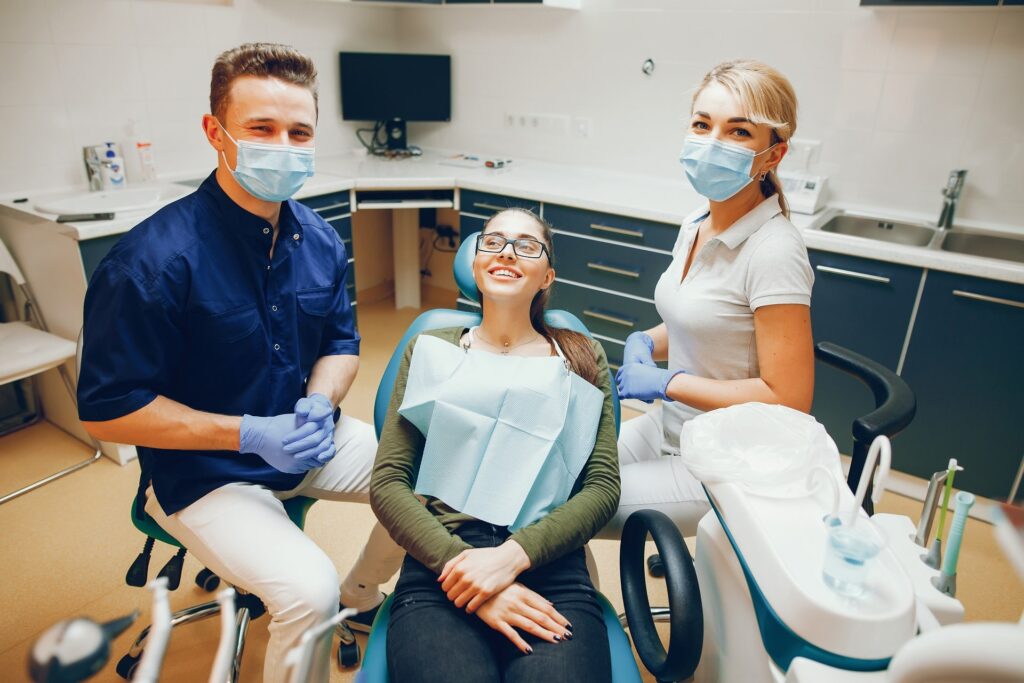Dental Fillings
Tooth Colored
 Dental composites are also called white fillings, used in direct fillings. Crowns and in-lays can also be made in the laboratory from dental composites. These materials are similar to those used in direct fillings and are tooth coloured. Their strength and durability is not as high as porcelain or metal restorations and they are more prone to wear and discolouration.
Dental composites are also called white fillings, used in direct fillings. Crowns and in-lays can also be made in the laboratory from dental composites. These materials are similar to those used in direct fillings and are tooth coloured. Their strength and durability is not as high as porcelain or metal restorations and they are more prone to wear and discolouration.
Composite Resin
 Dental composites, also called white fillings, are a group of restorative materials used in dentistry. As with other composite materials, a dental composite typically consists of a resin-based matrix, such as a bisphenol A-glycidyl methacrylate BISMA resin like urethane dimethacrylate (UDMA), and an inorganic filler such as silicon dioxide silica. Compositions vary widely, with proprietary mixes of resins forming the matrix, as well as engineered filler glasses and glass ceramics. The filler gives the composite wear resistance and translucency. A coupling agent such as silane is used to enhance the bond between these two components. An initiator package begins the polymerization reaction of the resins when external energy (light/heat etc.) is applied. A catalyst package can control its speed. This is not recommended for molars.
After tooth preparation, a thin glue or bonding material layer is applied. Composites are then filled layer by layer and photo-polymerising each using light. At the end the surface will be shaped and polished.
Dental composites, also called white fillings, are a group of restorative materials used in dentistry. As with other composite materials, a dental composite typically consists of a resin-based matrix, such as a bisphenol A-glycidyl methacrylate BISMA resin like urethane dimethacrylate (UDMA), and an inorganic filler such as silicon dioxide silica. Compositions vary widely, with proprietary mixes of resins forming the matrix, as well as engineered filler glasses and glass ceramics. The filler gives the composite wear resistance and translucency. A coupling agent such as silane is used to enhance the bond between these two components. An initiator package begins the polymerization reaction of the resins when external energy (light/heat etc.) is applied. A catalyst package can control its speed. This is not recommended for molars.
After tooth preparation, a thin glue or bonding material layer is applied. Composites are then filled layer by layer and photo-polymerising each using light. At the end the surface will be shaped and polished.
Glass Ionomer Cement
 A glass ionomer cement (GIC) is one of a class of materials commonly used in dentistry as filling materials and luting cements. These materials are based on the reaction of silicate glass powder and polyalkeonic acid. These tooth-coloured materials were introduced in 1972 for use as restorative materials for anterior teeth (particularly for eroded areas, Class III and V cavities).
As they bond chemically to dental hard tissues and release fluoride for a relatively long period modern day applications of GICs have expanded. The desirable properties of glass ionomer cements make them useful materials in the restoration of carious lesions in low-stress areas such as smooth-surface and small anterior proximal cavities in primary teeth. Results from clinical studies also support the use of conventional glass ionomer restorations in primary molars. They need not be put in layer by layer, like in composite fillings.
A glass ionomer cement (GIC) is one of a class of materials commonly used in dentistry as filling materials and luting cements. These materials are based on the reaction of silicate glass powder and polyalkeonic acid. These tooth-coloured materials were introduced in 1972 for use as restorative materials for anterior teeth (particularly for eroded areas, Class III and V cavities).
As they bond chemically to dental hard tissues and release fluoride for a relatively long period modern day applications of GICs have expanded. The desirable properties of glass ionomer cements make them useful materials in the restoration of carious lesions in low-stress areas such as smooth-surface and small anterior proximal cavities in primary teeth. Results from clinical studies also support the use of conventional glass ionomer restorations in primary molars. They need not be put in layer by layer, like in composite fillings.
Porcelain (Ceramics)
 Full-porcelain (ceramic) dental materials include porcelain, ceramic or glasslike fillings and crowns (a.k.a jacket crown, as a metal free option). They are used as in-lays, on-lays, crowns and aesthetic veneers. A veneer is a very thin shell of porcelain that can replace or cover part of the enamel of the tooth. Full-porcelain (ceramic) restorations are particularly desirable because their color and translucency mimic natural tooth enamel.
Another type is known as porcelain-fused-to-metal, which is used to provide strength to a crown or bridge. These restorations are very strong, durable and resistant to wear, because the combination of porcelain and metal creates a stronger restoration than porcelain used alone.
One of the advantages of computerized dentistry (CAD/CAM technologies) is that it enabled the application of zirconium-oxide (ZrO2). The introduction of this material in restorative and prosthetic dentistry is most likely the decisive step towards the use of full ceramics without limitation. With the exception of zirconium-oxide, existing ceramics systems lack reliable potential for the various indications for bridges without size limitations. Zirconium-oxide with its high strength and comparatively higher fracture toughness seems to buck this trend. With a three-point bending strength exceeding nine hundred megapascals, zirconium-oxide can be used in virtually every full ceramic prosthetic solution, including bridges, implant supra structures and root dowel pins.
Previous attempts to extend its application to dentistry were thwarted by the fact that this material could not be processed using traditional methods used in dentistry. The arrival of computerized dentistry enables the economically prudent use of zirconium-oxide in such elements as base structures such as copings and bridges and implant supra structures. Special requirements apply to dental materials implanted for longer than a period of thirty days. Several technical requirements include high strength, corrosion resistance and defect-free producibility at a reasonable price.
Ever more stringent requirements are being placed on the aesthetics of teeth. Metals and porcelain are currently the materials of choice for crowns and bridges. The demand for full ceramic solutions, however, continues to grow. Consequently, industry and science are increasingly compelled to develop full ceramic systems. In introducing full ceramic restorations, such as base structures made of sintered ceramics, computerized dentistry plays a key role.
Full-porcelain (ceramic) dental materials include porcelain, ceramic or glasslike fillings and crowns (a.k.a jacket crown, as a metal free option). They are used as in-lays, on-lays, crowns and aesthetic veneers. A veneer is a very thin shell of porcelain that can replace or cover part of the enamel of the tooth. Full-porcelain (ceramic) restorations are particularly desirable because their color and translucency mimic natural tooth enamel.
Another type is known as porcelain-fused-to-metal, which is used to provide strength to a crown or bridge. These restorations are very strong, durable and resistant to wear, because the combination of porcelain and metal creates a stronger restoration than porcelain used alone.
One of the advantages of computerized dentistry (CAD/CAM technologies) is that it enabled the application of zirconium-oxide (ZrO2). The introduction of this material in restorative and prosthetic dentistry is most likely the decisive step towards the use of full ceramics without limitation. With the exception of zirconium-oxide, existing ceramics systems lack reliable potential for the various indications for bridges without size limitations. Zirconium-oxide with its high strength and comparatively higher fracture toughness seems to buck this trend. With a three-point bending strength exceeding nine hundred megapascals, zirconium-oxide can be used in virtually every full ceramic prosthetic solution, including bridges, implant supra structures and root dowel pins.
Previous attempts to extend its application to dentistry were thwarted by the fact that this material could not be processed using traditional methods used in dentistry. The arrival of computerized dentistry enables the economically prudent use of zirconium-oxide in such elements as base structures such as copings and bridges and implant supra structures. Special requirements apply to dental materials implanted for longer than a period of thirty days. Several technical requirements include high strength, corrosion resistance and defect-free producibility at a reasonable price.
Ever more stringent requirements are being placed on the aesthetics of teeth. Metals and porcelain are currently the materials of choice for crowns and bridges. The demand for full ceramic solutions, however, continues to grow. Consequently, industry and science are increasingly compelled to develop full ceramic systems. In introducing full ceramic restorations, such as base structures made of sintered ceramics, computerized dentistry plays a key role.
Comparison
- Composites and Amalgam are used mainly for direct restoration. Composites can be made of color matching the tooth, and surface can be polished after filling.
- Amalgam fillings expand with age, possibly cracking the tooth and requiring repair and filling replacement. But chance of leakage of filling is less.
- Composite fillings shrink with age and may pull away from the tooth allowing leakage. If leakage is not noticed early recurrent decay may occur.
- Fillings have a finite lifespan: an average of 12.8 years for amalgam and 7.8 years for composite resins.Fillings fail because of changes in the filling, tooth or the bond between them. Secondary caries formation can also affect the structural integrity the original filling. Fillings are recommended for small to medium sized restorations.
- Porcelain and Gold are used for indirect restorations like crowns and partial coverage crowns (onlays). Some types of porcelains are hard, but can cause wear on opposing teeth. They are brittle and are not always recommended for molar restorations. A new material called lithium disilicate (ips.emax) is indicated for use on molars for crowns and onlays now because it is fracture resistant compared to other porcelains used for dental restorations
Doctor's Profile
Dr. Thomas
BDS., FFDRCSI.
(Fellow of Royal College of Surgeons, Ireland) FICOI, (Fellow of the International Congress of Oral Implantologists).
Specialist Dental Implant Surgeon.
Ask the Expert Have a Question?
Send an email or discuss your dental problem with Dr.Biju Thomas
schedule your appointment
professional expertise
- Our dental solutions are modeled on international healthcare standards
- All patients are personally overseen and treated by Dr. Thomas himself
- Associated with master dental technicians with 3-D precision bone scan facility
contact us
Schedule your evaluation right now!
Recover the will to smile with freedom and comfort




